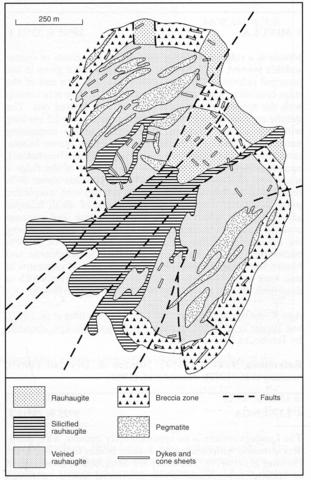stripes
The isolated hill of Nkombwa rises to just over 300 m above the surrounding plain of Precambrian basement rocks. The upper part of the hill comprises a 1x1.5 km carbonatite intrusion, the lower part fenitized granitic gneisses. Several types of carbonatite were mapped by T. Deans (pers. comm., 1988), but a more detailed map is now available (Zambezi et al., 1997). These authors show that the hill consists of ankeritic dolomite carbonatite and veined ankeritic dolomite carbonatite which are cut by sills and dykes 1-2 m wide of ferrocarbonatite. Some of the carbonatites are intensely silicified. Within the ferrocarbonatites are green to yellow angular carbonatitic xenoliths which Zambezi et al. (1997) consider represent an earlier carbonatite phase. No igneous silicate rocks appear to be present. Apart from the rock-forming carbonates the carbonatites also contain a little sodic amphibole and phlogopite, the latter being very abundant near the outer contacts where they grade into phlogopite-rich rocks that are essentially ultra-fenites. Accessory minerals include apatite, pyrite, magnetite, ilmenite, barite, monazite, pyrochlore, rare sellaite and the Ca-Mg phosphate isokite which was first described from this locality (Deans and McConnell, 1955) and is a relatively widespread phase. The green xenoliths in the ferrocarbonatite, according to Zambezi et al. (1997), owe their green colour to monazite, whereas the yellow xenoliths contain bastnasite, together with monazite and barite in a matrix of dolomite. These authors give four whole rock analyses of yellow xenoliths, which indicate total REE of >20%, and probe analyses of monazite-(Ce) and bastnasite-(Ce). Woolley and Buckley (1993) have found that the Ca-Mg-Fe carbonates are dominantly dolomite-ankerite but that a complete series from magnesite to siderite is also present.
DEANS, T. and MCCONNELL, J.D.C. 1955. Isokite, CaMgPO4F, a new mineral from Northern Rhodesia. Mineralogical Magazine, 30: 681-90.REEVE, W.H. and DEANS, T. 1954. An occurrence of carbonatite in the Isoka District of Northern Rhodesia. Colonial Geology and Mineral Resources, 4: 271-81.SNELLING, N.J. 1962. Age Determination Unit. Overseas Geological Surveys, Report for 1960-61, 27-35.TURNER, D.C., ANDERSEN, L.S., PUNUKOLLU, S.N., SLIWA, A. and TEMBO, F. 1989. Igneous phosphate resources in Zambia. In A.J.G. Notholt, R.P. Sheldon and D.F. Donaldson (eds), Phosphate deposits of the world, 2. Phosphate rock resources. 247-57. Cambridge University Press, Cambridge. WOOLLEY, A.R. and BUCKLEY, H.A. 1993. Magnesite-siderite series carbonates in the Nkombwa and Newania carbonatite complexes. South African Journal of Geology, 96: 126-30. ZAMBEZI, P., VONCKEN, J.H.L., HALE, M. and TOURET, J.L.R. 1997. Bastnasite-(Ce) at the Nkombwa Hill carbonatite complex, Isoka District, northeast Zambia. Mineralogy and Petrology, 59: 239-50.

